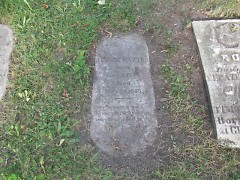The Fulton Street Cemetery is home to men and women who made this city what it is today. Many of the things we enjoy in this city were created by the settlers of a tiny frontier town called Grand Rapids.
“The people in this cemetery are responsible for a lot of the companies, organizations, and planned infrastructure that are still present in the city today,” Dilley emphasized.
John Ball
One of the most famous is John Ball. Many of us enjoy John Ball Park Zoo but know nothing about him. John Ball was born on November 12, 1794 in New Hampshire. George Washington was president, and no white man had yet reached what was to become Grand Rapids. John Ball was part of an expedition to what is now Oregon and planted the first corn there. He sailed on a ship for two years from the Sandwich Islands, (now Hawaiian Islands), sailing around the Cape Horn. He served in the Michigan State Legislature and later donated the land that is now John Ball Park. John Ball lived to be 90 years old and is buried under a huge rock that was quarried out of the side of the hill at the park. Ball’s grave is located along a path on the far east side of the cemetery.
The Butterworths
Richard and Ann Butterworth immigrated to Michigan from Manchester, England. Richard was unsuccessful in the foundry business before he created and produced logging cars for trains. This was at the time of the booming furniture business in this city. This made the Butterworths very wealthy, and they donated large sums of money to St. Mark's Episcopal Church, of which they were prominent members. They were responsible for the creation of St. Mark’s Home and Hospital. Later, this institution was renamed Butterworth Hospital. The Butterworth Family plot is located on the top of the hill on the north side of the cemetery.
Captain Samuel Judd
There are a number of Civil War casualties buried in Fulton Street cemetery. Captain Samuel Judd served in the 3rd Michigan Infantry Volunteers during the civil war. He was killed in the battle of Fair Oaks and is buried beneath a large monument at the highest point in the cemetery. The marker was donated by the men he served with and an inscription on the side reads, “This monument was erected by members of his company who loved him as a brother, obeyed with alacrity his commands and will during life cherish the remembrance of his courage and patriotism.”
“This monument is rare. It shows that his men cared about him so much they wanted it carved in stone,” Dilley explained.
Carl Hohoff
There are some sad stories at Fulton Street as well. Carl Hohoff owned and operated the Alaskan Fur Company. The building still stands and is located next to the Jimmy John's in Monroe Center. After his wife died, someone embezzled his fortune. He disappeared for a while and his body ended up in the Grand River. The cause of death was never determined. He was a member of the Woodmen of the World, a fraternal organization that still exists today. It was the policy of the organization that no member would lie in an unmarked grave. They erected the tree stump style grave marker at Hohoff’s grave. This type of marker was placed on members graves in the Midwest between 1860-1940. It is unique and can still be seen in cemeteries around the city.
Albert Baxter
Albert Baxter was born in 1823 in Vermont. He started west around the age of twenty. In 1846 he came to Grand Rapids. He was the editor of the Grand Rapids Eagle, one of the city’s early newspapers, and was the author of the famous 1891 History of Grand Rapids. In 1849, Baxter married the daughter of Joel Guild.
“Guild built the first frame house in what is now Grand Rapids,” Dilley explained.
Baxter died in 1905 and is buried on the north east part of the cemetery. Guild’s headstone is in front of Baxter's.
Charles H. Leonard
Charles H. Leonard, founder of the Leonard Refrigerator Company, invented the famous Leonard “Cleanable” Refrigerators. The electric refrigerator was introduced in 1918. By 1925, Leonard was building one out of every five refrigerators produced in the United States. His company merged with Kelvinator in 1926, which employed many people in the city for years. The Leonard Family is buried near the eastern gate of the cemetery.
Wilder D. Foster
Wilder D. Foster was born in 1819 in New York. He served as Mayor of Grand Rapids in 1854 and was a member of the Michigan Senate from 1855-1856. In 1871, he was elected as a Republican from Michigan’s fourth congressional district to the 42nd United States Congress, where he served until his death in 1873. He is buried with his family near the eastern gate of the cemetery.
The Rapidian, a program of the 501(c)3 nonprofit Community Media Center, relies on the community’s support to help cover the cost of training reporters and publishing content.
We need your help.
If each of our readers and content creators who values this community platform help support its creation and maintenance, The Rapidian can continue to educate and facilitate a conversation around issues for years to come.
Please support The Rapidian and make a contribution today.




Comments
I'd love to spend an afternoon or two or twenty exploring the cemetary and paying my respects to some of the city's founders. Thanks for this very interesting two-part story!